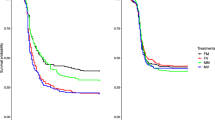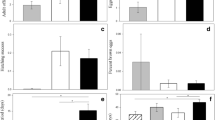Abstract
The risk of disease transmission can affect female mating rate, and thus sexual conflict. Furthermore, the interests of a sexually transmitted organism may align or diverge with those of either sex, potentially making the disease agent a third participant in the sexual arms race. In Drosophila melanogaster, where sexual conflict over female mating rate is well established, we investigated how a common, non-lethal virus (sigma virus) might affect this conflict. We gave uninfected females the opportunity to copulate twice in no-choice trials: either with two uninfected males, or with one male infected with sigma virus followed by an uninfected male. We assessed whether females respond behaviorally to male infection, determined whether male infection affects either female or male reproductive success, and measured offspring infection rates. Male infection status did not influence time to copulation, or time to re-mating. However, male infection did affect male reproductive success: first males sired a significantly greater proportion of offspring, as well as more total offspring, when they were infected with sigma virus. Thus viral infection may provide males an advantage in sperm competition, or, possibly, females may preferentially use infected sperm. We found no clear costs of infection in terms of offspring survival. Viral reproductive success (the number of infected offspring) was strongly correlated with male reproductive success. Further studies are needed to demonstrate whether virus-induced changes in reproductive success affect male and female lifetime fitness, and whether virus-induced changes are under male, female, or viral control.



Similar content being viewed by others
References
Able DJ (1996) The contagion indicator hypothesis for parasite-mediated sexual selection. Proc Natl Acad Sci USA 93(5):2229–2233. doi:10.1073/pnas.93.5.2229
Alatalo RV, Burke T, Dann J, Hanotte O, Hoglund J, Lundberg A, Moss R, Rintamaki PT (1996) Paternity, copulation disturbance and female choice in lekking black grouse. Animal Behaviour 52:861–873. doi:10.1006/anbe.1996.0234
Alcock J (1994) Post-insemination associations between males and females in insects — the mate-guarding hypothesis. Annu Rev Entomol 39:1–21
Allison PD (1995) Survival analysis using the SAS system: a practical guide. SAS Institute, Cary, NC
Andersson J, Borg-Karlson AK, Wiklund C (2004) Sexual conflict and anti-aphrodisiac titre in a polyandrous butterfly: male ejaculate tailoring and absence of female control. Proc R Soc Lond Ser B-Biol Sci 271(1550):1765–1770. doi:10.1098/rspb.2003.2671
Arnqvist G, Nilsson T (2000) The evolution of polyandry: multiple mating and female fitness in insects. Animal Behaviour 60:145–164
Arnqvist G, Rowe L (2002) Antagonistic coevolution between the sexes in a group of insects. Nature 415(6873):787–789
Ball MA, Parker GA (2003) Sperm competition games: sperm selection by females. J Theor Biol 224(1):27–42. doi:10.1016/s0022-5193(03)00118-8
Barker DM (1994) Copulatory plugs and paternity assurance in the nematode Caenorhabditis elegans. Animal Behaviour 48(1):147–156. doi:10.1006/anbe.1994.1221
Barta ZN, Houston AI, McNamara JM, Szekely T (2002) Sexual conflict about parental care: the role of reserves. Am Nat 159(6):687–705. doi:10.1086/339995
Bartholomew GA (1970) A model for the evolution of pinniped polygyny. Evolution 24(3):546–559
Birkhead TR, Moller AP, Sutherland WJ (1993) Why do females make it so difficult for males to fertilize their eggs. J Theor Biol 161(1):51–60. doi:10.1006/jtbi.1993.1039
Boorman E, Parker GA (1976) Sperm (ejaculate) competition in Drosophila melanogaster, and reproductive value of females to males in relation to female age and mating status. Ecol Entomol 1(3):145–155. doi:10.1111/j.1365-2311.1976.tb01217.x
Borgia G, Collis K (1989) Female choice for parasite-free male satin bowerbirds and the evolution of bright male plumage. Behav Ecol Sociobiol 25(6):445–453. doi:10.1007/bf00300191
Bretman A, Fricke C, Hetherington P, Stone R, Chapman T (2010) Exposure to rivals and plastic responses to sperm competition in Drosophila melanogaster. Behavioral Ecology 21(2):317–321. doi:10.1093/beheco/arp189
Brownlie JC, Cass BN, Riegler M, Witsenburg JJ, Iturbe-Ormaetxe I, McGraw EA, O'Neill SL (2009) Evidence for metabolic provisioning by a common invertebrate endosymbiont, Wolbachia pipientis, during periods of nutritional stress. PLoS pathogens 5(4):e1000368
Brun G, Plus N (1980) The viruses of Drosophila. In: Ashburner M, Wright TRF (eds) The genetics and biology of Drosophila, vol 2. Academic Press, London, pp 626–672
Burley NT, Foster VS (2006) Variation in female choice of mates: condition influences selectivity. Animal Behaviour 72:713–719. doi:10.1016/j.anbehav.2006.01.017
Chapman T (2001) Seminal fluid-mediated fitness traits in Drosophila. Heredity 87:511–521
Chapman T, Liddle LF, Kalb JM, Wolfner MF, Partridge L (1995) Cost of mating in Drosophila melanogaster females is mediated by male accessory gland products. Nature 373(6511):241–244
Chapman T, Arnqvist G, Bangham J, Rowe L (2003) Sexual conflict. Trends Ecol Evol 18(1):41–47
Clark AG, Begun DJ (1998) Female genotypes affect sperm displacement in Drosophila. Genetics 149(3):1487–1493
Clark MA, McCrady WB, Fieldling CL (1979) Independent production of CO2 sensitivity by nuclear gene-Dly and a transmissible agent from delayed-recovery Drosophila melanogaster. Genetics 92:503–510
Clark AG, Begun DJ, Prout T (1999) Female × male interactions in Drosophila sperm competition. Science 283(5399):217–220. doi:10.1126/science.283.5399.217
de Crespigny FEC, Wedell N (2006) Wolbachia infection reduces sperm competitive ability in an insect. Proc R Soc Lond Ser B-Biol Sci 273(1593):1455–1458. doi:10.1098/rspb.2006.3478
de Crespigny FEC, Hurst LD, Wedell N (2008) Do Wolbachia-associated incompatibilities promote polyandry? Evolution 62(1):107–122. doi:10.1111/j.1558-5646.2007.00274.x
Dewsbury DA (1982) Ejaculate cost and male choice. Am Nat 119(5):601–610
Drapeau MD, Cyran SA, Viering MM, Geyer PK, Long AD (2006) A cis-regulatory sequence within the yellow locus of Drosophila melanogaster required for normal male mating success. Genetics 172(2):1009–1030. doi:10.1534/genetics.105.045666
Fenton A, Johnson KN, Brownlie JC, Hurst GDD (2011) Solving the Wolbachia paradox: modeling the tripartite interaction between host, Wolbachia, and a natural enemy. Am Nat 178(3):333–342. doi:10.1086/661247
Fleuriet A (1981) Comparison of various physiological traits in flies (Drosophila melanogaster) of wild origin, infected or uninfected by the hereditary rhabdovirus sigma. Archives of Virology 69(3–4):261–272. doi:10.1007/bf01317341
Fleuriet A (1988) Maintenance of a hereditary virus, the sigma virus in populations of its host, Drosophila melanogaster. Evolutionary Biology 23:1–30
Fleuriet A (1996) Polymorphism of the Drosophila melanogaster — Sigma virus system. J Evol Biol 9:471–484
Garolla A, Pizzol D, Foresta C (2011) The role of human papillomavirus on sperm function. Curr Opin Obstet Gynecol 23(4):232–237. doi:10.1097/GCO.0b013e328348a3a4
Gilchrist AS, Partridge L (2000) Why it is difficult to model sperm displacement in Drosophila melanogaster: the relation between sperm transfer and copulation duration. Evolution 54(2):534–542. doi:10.1554/0014-3820(2000)054[0534:wiidtm]2.0.co;2
Grafe TU, Bitz JH (2004) Functions of duetting in the tropical boubou, Laniarius aethiopicus: territorial defence and mutual mate guarding. Animal Behaviour 68:193–201. doi:10.1016/j.anbehav.2003.11.003
Heifetz Y, Tram U, Wolfner MF (2001) Male contributions to egg production: the role of accessory gland products and sperm in Drosophila melanogaster. Proc R Soc Lond Ser B-Biol Sci 268(1463):175–180
Herndon LA, Wolfner MF (1995) A Drosophila seminal fluid protein, ACP26AA, stimulates egg-laying in females for 1 day after mating. Proc Natl Acad Sci USA 92(22):10114–10118. doi:10.1073/pnas.92.22.10114
Higgins LA, Jones KM, Wayne ML (2005) Quantitative genetics of natural variation of behavior in Drosophila melanogaster: the possible role of the social environment on creating persistent patterns of group activity. Evolution 59(7):1529–1539. doi:10.1554/04-762
Hosokawa T, Koga R, Kikuchi Y, Meng X-Y, Fukatsu T (2010) Wolbachia as a bacteriocyte-associated nutritional mutualist. Proc Natl Acad Sci USA 107(2):769–774. doi:10.1073/pnas.0911476107
Knell RJ, Webberley KM (2004) Sexually transmitted diseases of insects: distribution, evolution, ecology and host behaviour. Biological Reviews 79(3):557–581
L'Héritier P, Teissier G (1945) Transmission héréditaire de la sensibilité au gaz carbonique chez la Drosophile. Publ lab ENS Biologie 1:35–76
Luong LT, Kaya HK (2005) Sexually transmitted nematodes affect spermatophylax production in the cricket, Gryllodes sigillatus. Behav Ecol 16(1):153–158. doi:10.1093/beheco/arh146
Lupold S, Manier MK, Ala-Honkola O, Belote JM, Pitnick S (2011) Male Drosophila melanogaster adjust ejaculate size based on female mating status, fecundity, and age. Behavioral Ecology 22(1):184–191. doi:10.1093/beheco/arq193
Manier MK, Belote JM, Berben KS, Novikov D, Stuart WT, Pitnick S (2010) Resolving mechanisms of competitive fertilization success in Drosophila melanogaster. Science 328(5976):354–357. doi:10.1126/science.1187096
Mueller JL, Linklater JR, Ravi Ram K, Chapman T, Wolfner MF (2008) Targeted gene deletion and phenotypic analysis of the Drosophila melanogaster seminal fluid protease inhibitor Acp62F. Genetics 178:1605–1614
Parker GA (1970) Sperm competition and its evolutionary consequences in the insects. Biological Reviews 45:525–567
Perampaladas K, Stoltz JA, Andrade MCB (2008) Mated redback spider females re-advertise receptivity months after mating. Ethology 114(6):589–598. doi:10.1111/j.1439-0310.2008.01513.x
Pizzari T, Dean R, Pacey A, Moore H, Bonsall MB (2008) The evolutionary ecology of pre- and post-meiotic sperm senescence. Trends Ecol Evol 23(3):131–140. doi:10.1016/j.tree.2007.12.003
Radhakrishnan P, Perez-Staples D, Weldon CW, Taylor PW (2009) Multiple mating and sperm depletion in male Queensland fruit flies: effects on female remating behaviour. Animal Behaviour 78(4):839–846. doi:10.1016/j.anbehav.2009.07.002
Reinhardt K, Naylor R, Siva-Jothy MT (2011) Male mating rate is constrained by seminal fluid availability in bedbugs, Cimex lectularius. PLoS ONE 6(7):doi:e2208210.1371/journal.pone.0022082
Rowe L, Arnqvist G, Sih A, Krupa J (1994) Sexual conflict and the evolutionary ecology of mating patterns — water striders as a model system. Trends Ecol Evol 9(8):289–293. doi:10.1016/0169-5347(94)90032-9
Simmons LW (2005) The evolution of polyandry: sperm competition, sperm selection, and offspring viability. Annu Rev Ecol Evol Syst 36:125–146. doi:10.1146/annurev.ecolsys.36.102403.112501
Soller M, Bownes M, Kubli E (1999) Control of oocyte maturation in sexually mature Drosophila females. Developmental Biology 208(2):337–351. doi:10.1006/dbio.1999.9210
Thrall PH, Antonovics J, Dobson AP (2000) Sexually transmitted diseases in polygynous mating systems: prevalence and impact on reproductive success. Proc R Soc Lond Ser B-Biol Sci 267(1452):1555–1563
Wayne ML, Blohm GM, Brooks ME, Regan KL, Brown BY, Barfield M, Holt RD, Bolker BM (2011) The prevalence and persistence of sigma virus, a biparentally transmitted parasite of Drosophila melanogaster. Evol Ecol Res 13:323–345
Wigby S, Sirot LK, Linklater JR, Buehner N, Calboli FCF, Bretman A, Wolfner MF, Chapman T (2009) Seminal fluid protein allocation and male reproductive success. Current Biology 19(9):751–757. doi:10.1016/j.cub.2009.03.036
Yampolsky LY, Webb CT, Shabalina SA, Kondrashov AS (1999) Rapid accumulation of a vertically transmitted parasite triggered by relaxation of natural selection among hosts. Evol Ecol Res 1:581–589
Zeh JA, Zeh DW (2003) Toward a new sexual selection paradigm: polyandry, conflict and incompatibility (Invited article). Ethology 109(12):929–950
Acknowledgements
We thank Sebastian Vasquez and Lyvie-Sara Sylvestre for help keeping the flies and setting up experiments, and H. Jane Brockmann and L. Sirot for helpful discussions. This work was funded by National Institutes of Health grant GM083192.
Author information
Authors and Affiliations
Corresponding author
Additional information
Communicated by S. Cremer
Electronic supplementary materials
Below is the link to the electronic supplementary material.
ESM 1
(DOC 336 kb)
Rights and permissions
About this article
Cite this article
Rittschof, C.C., Pattanaik, S., Johnson, L. et al. Sigma virus and male reproductive success in Drosophila melanogaster . Behav Ecol Sociobiol 67, 529–540 (2013). https://doi.org/10.1007/s00265-012-1472-7
Received:
Revised:
Accepted:
Published:
Issue Date:
DOI: https://doi.org/10.1007/s00265-012-1472-7




